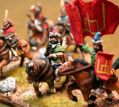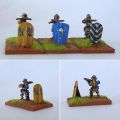Later Bulgarian
Historical Overview Section
The Second Bulgarian Empire existed between 1185 and 1396 (or 1422). A successor of the First Bulgarian Empire, it reached the peak of its power under Kaloyan and Ivan Asen II before gradually declining to be conquered by the Ottomans in the late 14th-early 15th century. This list covers the Empire from 1300 to its annexation by the Later Ottoman Turkish army. This era sits in the period of decline as Tatar raids in the Balkans in the early 13th century had devastated Bulgaria. The Decline and Fall era Empire of Nicaea had annexed Bulgarian territory in Macedonia and Thrace whilst the Early Hungarian kingdom had occupied Belgrade. A swineherd Ivailo managed to sit on the Bulgarian throne from 1277 to 1280, defeat the Byzantines in two major battles and temporarily drove away the Tatars from the northeastern parts of the Empire but his brand of off with their heads proto communism meant that he wasn't especially popular with the aristocracy and was later killed. The Tatar hegemony continued to 1300 when khan Toktu ceded Bessarabia the new Bulgarian Emperor Theodore Svetoslav. Svetoslavs Bulgaria regained much of its former strength and prestige. After a successful war against Byzantium things looked good up until his death in 1322. But the tatars werent finished and Ozbeg Khan (1313-41) repeatedly raided Thrace for 40 days in 1324 and for 15 days in 1337 taking 300,000 captives. After Ozbeg's death in 1341, his successors did not continue his aggressive policy and Bulgaria breathed a sigh of relief.
In 1330 the Bulgarians under the latest star man, Michael III were heavily defeated by the Later Serbian army at Velbuzhd, and some parts of the Empire came under Serbian sway. Under Ivan IV (Ivan Alexander; 1331–1371) Serbian threat ended and the Late Byzantines were defeated at Rusokastro in a period which became known as the Second Golden Age because of its thriving cultural life. After Ivan Alexander's death Bulgaria was left divided into rival states; one of the two largest ones was based at Veliko Tarnovo, and the other at Vidin, ruled by Ivan's two sons. The two brothers and despot Dobrotitsa from the Principality of Carvuna did not make an attempt to unite and they were even engaged in a military conflict for Sofia. Weakened Bulgaria was thus no match for a new threat from the south, the Early Ottoman Turkish Empire, who's army crossed into Europe in 1354. In 1362 they captured Philippopolis (Plovdiv), taking Sofia in 1382. The Ottomans then turned their attention to the Serbs, whom they routed at Kosovo Pole in 1389. In 1393 the Ottomans occupied Tarnovo after a three-month siege. In the next year the Ottomans captured the Carvuna Principality and Nikopol — the last town of the Tarnovo tsardom — fell in 1395. Next year the Kingdom of Vidin was also occupied, bringing the Second Bulgarian Empire and Bulgarian independence to an end.
The Bulgarian army had once been one of the most feared and efficient in Europe, but after the rebellion of Ivailo the Bulgarians proved no match for the Mongols who plundered the country undisturbed for 20 years. Theodore Svetoslav improved the army and by the time of his successor records show the garrison of Plovdiv numbered 2,000 heavily armed footmen and 1,000 horsemen. In 1330 Michael III Shishman raised a 15,000-strong army to face the Serbs but was defeated at the battle of Velbazhd. Two years later the Bulgarian army numbered 11,000 men. Buy by the time of the Ottoman invasion the army had again faded and so the Bulgarians relied on their fortified cities and castles for defense, but due to the lack of a common leadership, coordination amongst them was feeble and they were defeated and occupied in detail.
Using the army in FoG
- Unusually, the army has options for both lancers and Bw/Sw Shooty cavalry, although the Bw/Sw bows are a bit rubbish on account of being only protected at best.
- This means you will probably be using a wall of lancers, and relying on a mix of Bulgarian LH and Proteched shooty cavalry to protect your flanks.
- 18 spearmen is enough not to be sniffed at, and can also do a job for you in protecting a flank or occupying space on table
- The Greek Poor drilled lancers may also be worth a punt, as being regular they can do the clever "move full speed and turn 90 degrees" trick, allowing them to put in a half decent flank charge if your enemy obliges. And anyway, lancers are usually a POA up at impact, so being Poor in the impact round isn't too bad.
UK Tournament Results with this army
Useful Links
User-contributed links about this army:
- Bulgarian Serbian Wars on Wikipedia
- Bulgarian Ottoman Wars on Wikipedia
- Later Bulgars DBA Figure Gallery for this army - from Fanaticus
- put the link text readers will see in here write some more detail about the link here
Allies
No allied contingents, even though there seems a good shout to have some Tatar troops at some stage.
15mm Manufacturers supplying figures for this army
Many manufacturers have generic Medieval and East European ranges - those noted have specific (or particularly good) relevant figres
You can see some of the figures in the Ancients Photo Gallery also on this site

|

|

|

|

|
- Essex Miniatures - Several East European Medieval ranges
- Donnington C13-5 East Europe Ranges
- Vexilia - v good East European ranges
- Museum Miniatures East Europeans
- Gladiator Miniatures by Fighting 15's (Previously Black Hat) - East European range
- Old Glory 15's, East European and Russian ranges
- fighting 15's - Uk supplier for Oddzial Ozmy's Polish-cast 1410 Tannenberg Teutonics, Polish & Lithuanians
- East Riding Miniatures
- Isarus - sold by 15mm.co.uk E. European Medieval range
- Viking Forge
- Irregular Miniatures 60 medievals in a range spanning East & West Europe from Late Feudal to C15
- Lancashire Games Around 30 generic & English medievals
- Tin Soldier 40 C14 & C15 medievals, including equipment
- Minifigs UK Some Bulgarian cavalry from this period
- Camelot Games (Italy) Rus and CXIII medievals
- Naismith & Roundway Many eastern European nations covered
Core Troops
Which troops are absolutely needed for this army, and what are your thoughts on how to organise, paint and buy them.
Army Lists
Sample army lists for this army
Name of Army / Date
- Using asterisks inthe edit mode creates a bulleted list in the actual site
- This is a lot easier to do than easier than setting up tables
- For FoG I suggest listing your army in order or march
- with troop desctiptions on each line, for example
- 4 HF Armoured Average Drilled Impact Foot Swordsmen
- 8 LG Undrilled Unarmoured Poor Bowen
- Dont forget to include your Generals !!!
Include any notes you want here, including comments on how to use - or play against - the army.
Remember to leave a line before you copy the above section as a template for your own list
eBay Listings
UK Bookstore